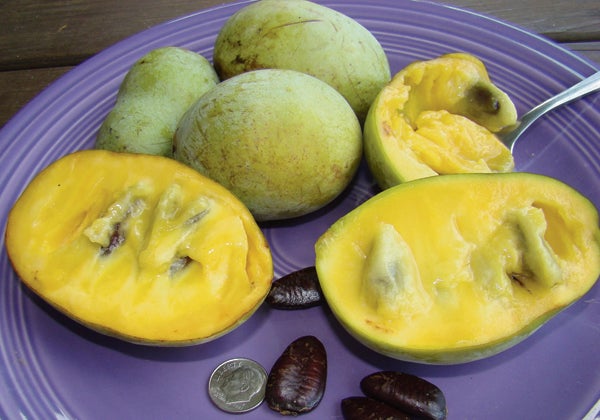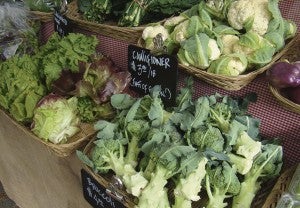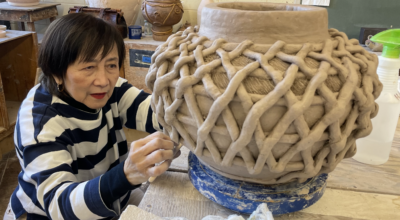Consumer Qs: hard freeze, yellow dishes, pawpaws, broccoli stems
Published 11:12 am Friday, February 12, 2016

- The Georgia native pawpaw is an interesting fruit with an aromatic, custard-like flesh.
Question: What exactly is a “hard freeze?” I heard that some plants will tolerate a frost but not a hard freeze.
Answer: In general, a “hard freeze” implies that temperatures are sufficiently cold for a long enough period to seriously damage or kill warm-season vegetation. In our area, this usually means temperatures falling into the upper 20s or lower for at least two to three hours. For example, a hard freeze will kill unprotected tender annuals or kill back the foliage on some hardy perennials.
Some weather service offices have established specific criteria for a hard freeze watch or warning that may be more detailed and precise. These notices alert people to the potential damage or danger to water pipes, radiators, pets and livestock as well as to sensitive plants.
When a reference book or a garden authority says that a plant will not tolerate a hard freeze, they generally mean the plant may tolerate (or at least survive with little damage) temperatures in the low 30s or high 20s for brief periods.
Q: Is it true that there are yellow radishes?
A: Yes. You may want to try ‘Beauty Blend,’ a mix of yellow, white, red, pink and purple radishes, from Park Seed (3507 Cokesbury Rd., Hodges, SC 29653 Phone: 1-800-845-3369) or ‘Mardi Gras Mix,’ a mix of purple, yellow, white and black radishes from Burpee (300 Park Ave., Warminster, PA 18974 Phone:1-800-888-1447). Baker Creek Heirloom Seeds (2278 Baker Creek Rd., Mansfield, MO 65704 Phone: 417-924-8917) offers two different yellow radishes: ‘Helios’ and ‘Zlata.’
Q: Where can I learn more about growing and using our native pawpaw?
A: The website of the Kentucky State University Pawpaw Program (http://www.pawpaw.kysu.edu/) is an excellent source of information about pawpaw research as well as an archive of news stories about the pawpaw and even offers a few recipes.
You may also visit the Georgia Department of Agriculture website (www.agr.georgia.gov) to read about our experience. Click on “News” and then “Put a Pawpaw in Your Pocket” in the “Arty’s Garden” section. Those without internet access can write: Georgia Department of Agriculture, 19, MLK Jr. Drive, Room 128, Atlanta, GA 30334, to receive printed copies of information.
Those really interested in learning more should read Pawpaw: In Search of America’s Forgotten Fruit by Andrew Moore (perhaps the most complete and authoritative book on pawpaws to date) and these two books by Lee Reich: Uncommon Fruits for Every Garden and Uncommon Fruits Worthy of Attention.
When searching for pawpaw information on the internet, please note that some people use the word “pawpaw” to refer to papaya (Carica papaya), not to our native pawpaw (Asimina triloba).
Q: Are you supposed to eat broccoli stems? I was shocked to witness a cook throw some away and only use the tops.
A: There are some recipes that call only for using the florets in order to create a dish that has a consistent look, texture or taste, but broccoli stems are edible, delicious and useful, and it is a shame to waste them.
Broccoli stems may be steamed or roasted like the florets. They may be eaten raw and used like carrot sticks for dipping into salad dressing or hummus. Some people use them to make slaw, slice them thin for salads or use them in soups. Larger, older stems can have a tough skin and fibrous layer that is easily peeled away to get to the crunchy center. (Young, small stems, especially the very fresh ones you harvested from your own garden, may not require peeling.) The flavor of the stems is milder than the florets, and they may be a good way to introduce finicky, green-vegetable-averse children to broccoli.
And, by the way, you can eat broccoli leaves, too! Use them in salads and soups or cook them like other greens.
If you have questions about services or products regulated by the Georgia Department of Agriculture, write Arty Schronce (arty.schronce@agr.georgia.gov) or visit the department’s website at www.agr.georgia.gov







